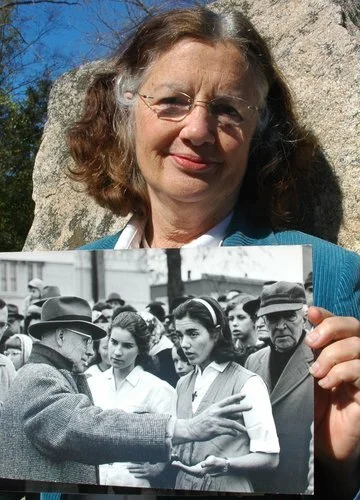“I’m going to run it anyway”
A glimpse at the life achievements of Dr. Julia Chase-Brand, first female road racer in American history
by Rebecca Tolkoff
All week a memory of my biology lab professor talking my pre-med class down from a mid-exam anxiety attack replayed in my mind. The professor’s name escaped me, but her long gray braid held firmly in my memory, and her message was simple. It is one that has come in handy during many difficult and uncomfortable moments in the quarter century since I heard them. Your misery will end. This feeling of discomfort and worry will end…in about 45 minutes. This is a coping technique that comes in handy during the last few miles of a marathon, during childbirth, and during other particularly awful experiences. My mission in calling Dr. Julia Chase-Brand, the first American woman to run a road race, was simply to ask her if she was the bio professor who gave out this valuable advice back in 1994.
I posted on a college Facebook group, and Lori Hoeper, Biology major and class of ’94, answered my FB post within a few hours. She generously gave me time on the phone and assured me that the professor in my memory was definitely not Dr. Chase-Brand, because Dr. Chase-Brand always wore her dark hair in a bob and never had a long gray braid.
However, Lori really loved Dr. Chase-Brand, and explained she was the kind of professor who educated her students in subject matter but also placed equal emphasis in teaching how to navigate life as a strong woman. You would think Barnard College in the 1990’s would represent the epitome of women’s equality. Dr. Chase-Brand was in the process of making a career switch and shared a surprising story of misogyny and discrimination she received at her own University. The story is one Lori has repeated to her own students, as she is now a professor of Public Health at SUNY Brooklyn.
After a nearly 30-year academic career at Rutgers University and Barnard College (Columbia University), Dr. Chase-Brand decided to pursue her dream of becoming a medical doctor. Her youngest child was finishing up high school, and she felt there was space for medical school. She figured the application to the Columbia School of Medicine was a logical choice, all things considered—being on staff and a colleague of the medical professors. At the interview, the Dean of Admission greeted her with something along the lines of, hello Julia, shouldn’t you be at home making cookies with your grandkids? That interview ended there at that moment. Julia walked out. The Dean’s office sent a note the next day asking her to come back in, but Julia was not going to waste any more of her time. The prejudice of the old boys’ network rang loud and clear. Albert Einstein Medical School gladly accepted her, providing a more progressive and forward-thinking community. In 1996, at the age of 53, and yes, a grandmother, Dr. Chase-Brand graduated medical school. In fact, she became the oldest woman to ever graduate medical school. Today, although more women are reinventing themselves in their 50’s, very few have graduated medical school past the age of 53.
I was glad to share some new information about Lori’s favorite professor during our phone call: Dr. Chase-Brand was a pioneer long before she graduated from med school, and long before she graduated from Smith College. A lot of Julia’s character was influenced and supported by her grandmother, Mary Foulke Morrisson. Mary graduated from Bryn Mawr in 1899 and worked in the Women’s Rights Movement, co-founding the League of Women’s Voters. Mary taught Julia to, “Aim for a full life, and to do good for others.” She encouraged her granddaughter’s creativity and freedom. Julia would go for runs in the woods as a girl. She would occasionally bring back a bird’s nest and her grandmother would help her figure out what kind of bird it was. Julia remained curious about the natural world and went on to major in Zoology. Julia also kept running.
Growing up in Groton, CT, one of her neighbors was John J. Kelley — the same John Kelley who ran 61 Boston marathons, the man depicted in a statue at the base of Heartbreak Hill. Back in the 1950s, runners were an elite group of men for whom Sunday ‘church’ meant going for a speedy long run. Julia struck up a conversation with John along his route one Sunday. She queried him about his views on women running long distance. Women were still barred from running Olympic distances longer than 400m. The Amateur Athletic Union (AAU) forbade women from racing distances longer than 800m in the United States.
Without hesitation, he replied that of course women could run distance and agreed to coach her. Julia learned from Coach John and was quickly running 60 miles a week. By 1960, Julia placed 5th in the 800m Olympic trials and set records for the 400m and 800m at the New England Championships.
Julia loved longer distances and wanted to race. She and her coach arrived at the Manchester Road Race ready to run in 1960. The race director forbade her participation and threatened to report her to the AAU. She stepped off the start line with frustration but assured the director he would see her the following year and she expected to be allowed to run. Julia thought running was a natural activity people had been doing since the beginning of history. She was surprised more people did not run.
In preparation for her return to the Manchester Road race, Julia showed up to the Cohasset 6.5 Mile Road Race in the fall of 1961. The race director allowed her to run along with the 34 men, though not in any official way. The running world and American society failed to support her heroic attempt at distance running. The Associated Press described her as a “curvaceous, 19-year old sophomore.” Whether there was support or not, people started to talk. Julia pushed against the idea that women should not run long distance. Before this race, there was NO REPORT of any American woman running a road race! A month later, she returned to the Manchester Road Race to right a wrong. The Manchester race director got right in her face a second time, angrily telling her she could not participate. There is a famous photo of his rant. He commanded a group of large burly men to physically block her path (and the path of the two other brave women who showed up in solidarity with her) Julia listened to the race director and told him she was going to run it anyway. The young female runners simply darted around them. Along the course fans cheered for them and their confidence increased.
Photo credit: Bill Hanrahan/Lawrence & Memorial Hospital
Lori Hoepner remarked that this story sounded like the professor she knew. Dr. Chase-Brand embodied the spirit of a trailblazer, doing new things and making them acceptable and popular. Julia returned to Manchester in 2011 and completed the Manchester Road Race once again. She was 69 years old and wore the same Smith College uniform she wore in 1961. Pioneering again, Julia was the first woman to run a race 50 years after her first run.
Julia running the Manchester Road Race
Photo credit: United Press International
““To be yourself in a world that is constantly trying to make you something else is the greatest accomplishment.” ”



